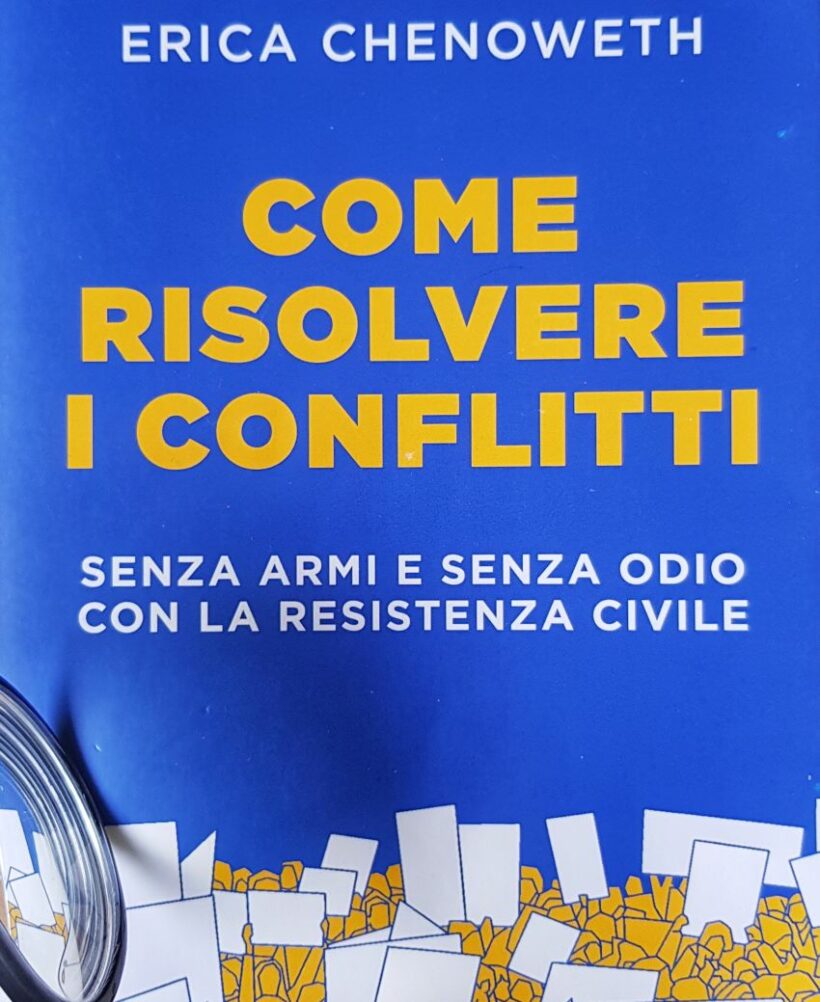At a time when not only has war returned even to Europe, but bellicism – that is, the ideology of war – has taken on an unprecedented media and political centrality in our country’s [i.e. Italy’s] republican history, the Italian translation of the important work on civil resistance by U.S. researcher Erica Chenoweth Come risolvere i conflitti. Senza armi e senza odio con la resistenza civile (2023) (How to Resolve Conflict. Without Weapons and Hate with Civil Resistance) – thanks to the efforts of Angela Dogliotti of the Sereno Regis Study Center in Turin and Edizioni Sonda – represents a counter-narrative to the diffusion of the inevitability of the violent outcome of conflicts; a true deconstruction of a myth. This volume is one of the outcomes of the ultra-decade-long study, carried out together with Maria Stephan, on the quantity and effectiveness of nonviolent struggles in the world from 1900 to the present, a systematic and reasoned representation of the evolution of nonviolence in conflicts over the past 120 years, the fruits of which overturn centuries of dominant thinking, including historiographical [thinking], according to which only “when there is war there is history” (Anna Bravo, The Count of the Saved, 2013). “Everyday life,” writes Erica Chenoweth, “is filled with countless stories, movies, myths and other cultural dreams that glorify violence. And this constant glorification of violence also serves to erase the extraordinary human history of civil resistance and popular movements that have waged nonviolent battles over millennia.”
Meanwhile, [here is] the pragmatic definition – as in the style of U.S. researchers, beginning with Gene Sharp’s landmark work The politics of nonviolent action (1973)-of civil resistance: “Civil resistance,” writes Erica Chenoweth, “is a method of direct action in which unarmed people use a variety of coordinated, non-institutional methods to promote change without physically harming or threatening to physically harm the opponent.” This means that civil resistance is an active method of managing social and political conflicts, which is acted out by citizens who intentionally renounce the use of violence – not because they are necessarily (and capitally, we might add) persuaded of the moral superiority of nonviolence, but because violence is mostly ineffective – and make use of various techniques of civil disobedience (strikes, protests, demonstrations, boycotts, alternative institution building and many others recounted in the documented volume) against unjust laws, oppressive regimes, military occupations.
Then the data: Between 1900 and 2019, 627 mass violent and nonviolent struggle campaigns were surveyed: 303 of these were predominantly violent in nature, while 324 relied on nonviolent civil resistance, including 96 in the 2010-2019 decade alone. Well, while only 26 percent of armed struggles were successful, more than 50 percent of nonviolent ones achieved their goals. “This is a staggering percentage that invalidates the widely held view that nonviolent action is weak and ineffective while violent action is strong and effective,” comments Chenoweth, who lists in the appendix all the campaigns of the past 120 years of history, with their respective outcomes. While mindful that social and political transformations are not once-and-for-all achievements, but require the efforts of multiple generations for them to be consolidated, Chenoweth outlines the main factors in the success of nonviolent struggles: participation: the broader and more diverse base of participants in a civil resistance campaign is, the more successful it is likely to be (empirically, critical mass has been seen to be the activation of 3.5 percent of citizens); adversarial defections: the ability of a movement to turn supporters of the power to its side; variety of tactics: struggles that are expressed through diversification of actions are more effective; and finally, self-discipline and resilience in the face of repression.
The historical reference point for all forms of civil resistance are, of course, the Gandhian campaigns for India’s independence and self-rule from British imperialism, with respect to which the objection that is always raised is that they could not have worked against a possible Nazi occupation. But this objection starts from two erroneous assumptions, Chenoweth explains, which it is worth reiterating again: “The first is the idea that the one established in India by the British Empire was a benevolent colonial system. The second is that Hitler’s regime never faced nonviolent resistance and still annihilated what little it found in its path.” The researcher deconstructs each of these assumptions, demonstrating both the ferocity of British colonial rule and its massacres, and the many effective nonviolent resistances – from Denmark to Norway, but also in Germany itself (e.g., the women of the Rosenstrasse, an episode also recounted in a film by Margarethe Von Trotta) – that successfully challenged the Nazi regime.
For that matter, let us finally add that in Ukraine too, many actions of civil resistance by citizens have been surveyed by various international research centers (e.g., by the International Catalan Institute for Peace), especially in the first months of Russian occupation, but they have been drowned out by the din of the Ukrainian government’s dominant narrative, supported by the mountain of Western weapons and amplified by Italian “information,” that there is no possible resistance outside of war. That is, the forced feeding of the myth of violence.
[Article published on I blogs del Fatto Quotidiano].






